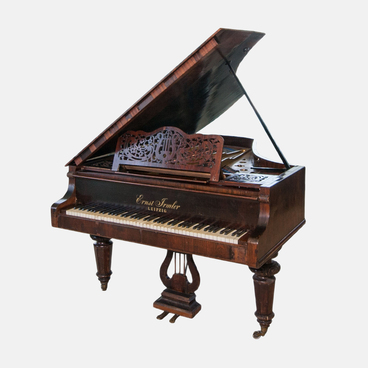In the first half of the 19thcentury, Germany became recognized as a major center of piano manufacturing, with the production levels steadily increasing.
In 1830, Heinrich Roloff established a piano factory in Neubrandenburg, Germany. After his death, the company was taken over by his sons Heinrich, Wilhelm, and August and remained a Roloff family business for over seven decades until it was closed in 1908.
Roloff pianos are recognized for their reliability and tonal beauty. There was only one drawback, but it was quite noticeable — the instruments had a dull and dry bass tone. In 1894, on the 50thanniversary of the first German trade fair in Berlin, Roloff’s products were awarded a silver medal. The company’s instruments were also recognized with various awards at other industrial exhibitions.
The lacquered case of the displayed piano is decorated with carved consoles and exotic wood veneers. The nickel-plated aluminum alloy candelabra mounted in the side sections of the upper front board were probably added later on and were not part of the original décor.
The instrument’s mechanism is simple, equipped with trackers (suspended wooden rods connecting the keys to the hammer) and lower dampers (stopping the vibration of the strings). The range of the piano spans seven octaves, A2–a2. The instrument is straight-strung and includes 15 one-string basses, 15 choruses (30 two-string basses), and 55 three-string choruses (smooth steel strings).
Such pianos could be used in movie theaters during the early era of cinema. This hypothesis is supported by the fact that there is a hole in the top of the board, probably intended for an electric cord, and two brackets for a lamp. Using the electric light, the pianist could play in a dark movie theater, providing musical accompaniment to a silent film.
The instrument is in working condition and is
played at museum events dedicated to art and history.


